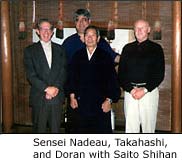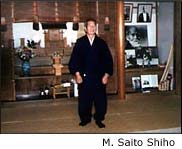

  |
|
vol 19, August 2001
Aikido Association of Northern California Trip to Japan, 1999
Aikido Association of Northern California Trip to Japan, 1999
Senseis Frank Doran, Robert Nadeau and Francis Takahashi organized a one-week trip to Japan for Aikido training at Hombu Dojo (www.aikikai.org) in the fall of 1999. Our group included several schools from California and totaled about 40 people. This is a personal account of my experiences during this visit.
After checking into the hotel, we went to the dojo for the 7 pm class. The dojo has four floors, with three training rooms. You remove your shoes in the foyer, before going into the building proper where everyone is barefoot or in socks. The main training room on the third floor has a thin tatami mat built into the floor. It's about a half-inch of straw covered by rough canvas, which generated some nasty blisters after a few days of training. There's a small changing room with lockers and showers. The showers have all had the handle to the warm water removed, so there are only cold showers. The toilets are on the second floor, and a row of sandals in a variety of sizes is lined up at the door - not using sandals to enter the toilets is a killing offense, as someone recently described it. TRAINING AT HONBU Training is pretty formal compared to dojos I've visited in the US and Europe; There's a bow-in when the teacher arrives, followed by warm-up exercises, then the teacher demonstrates a technique. When the teacher talks or demonstrates, everyone sits seiza and makes no movements - they even wait for the end of the demonstration to wipe sweat off (most folk bring little towels they leave on the side of the mat).
At Honbu, you train with the same partner for the entire class. There are also no colored belts - everyone is either a white belt or a black belt, and there appeared to be a few 6th dan training at many classes. Most folk from our group seemed to train one or two classes a day; I trained about 4 classes a day, and one of my friends did every single class, 6 per day. Of course, he couldn't use his left arm the last couple of days, but I think we were both happy to spend the majority of our time either training or resting from training. Generally, I'd train the first two classes in the morning, and the last two in the evening, ending at 8 pm. Afterwards I'd go to the local bath house (120º tubs!) and then go out for dinner. After the first day of training, jet lag and going to sleep were not problems. The teachers I saw are all shihan. They were quite diverse in their styles. Teachers were assisted for the most part by their respective uchi-deshi, who provided attacks for the demonstrations. In general, teachers tended to have particular uke they preferred, but we were fortunate in that several teachers chose people from our group as uke.
Watanabe Sensei was a larger fellow with a shaved head and a walrus-like mustache, accompanied by a mischievous look in his eyes. He did a lot of breath/energy work, and seemed to move his attackers like puppets without touching them. Feeling a bit skeptical of this, I attacked him pretty hard. My friends said that he was forced to change his style somewhat to deal with me, but I only recall touching him once. I think we all got a lot out of Watanabe Sensei's classes. The most inspirational class I attended was the daily 6:30 am class taught by Doshu, the grandson of O Sensei. His class has many older men, in their 60's, 70's, and perhaps even 80's. One fellow who picked me as his partner seemed so old and fragile that I was very concerned about injuring him, but I was quickly surprised to discover that he threw me harder than just about anyone else I trained with, and with almost no movement or effort. In general these old guys would check me out for the first 20 minutes of the class, then pound me for the second half, always with a very pleasant smile on their faces, and with apparently no effort whatsoever. IWAMA
We then went across the road to visit Saito Sensei who welcomed us very warmly. Large quantities of beer and chips were provided by Saito Sensei and his extremely attentive uchi-deschi, and we consumed them heartily. Soon everyone was smiling. Food was sent for and we had quite a party. Saito Sensei also presented us all with Japanese towels, or tenugui. He then proceeded to demonstrate the many uses of this cloth (gagging, strangling, blindfolding, etc.) on Cyndy Hayashi, a member of our group, to much applause and laughter. Later, just as we thought things were winding down, Saito Sensei produced the sake.
  By the time we returned to the train station my photos were becoming rather blurred, as I discovered later when I developed them. The return trip to Tokyo seemed somehow much shorter than the outgoing trip. OTHER INCIDENTS A couple of incidents at Honbu Dojo are worth remarking upon. For example, we had a 5th kyu in our group who one night found himself training with a 5th dan. The latter gave our student a very hard time, continuing to crank away on his arm when he was tapping furiously on the mat. The student feared greatly for his well-being, and this incident caused him much distress. On a more positive note, I have heard stories of Japanese students avoiding American or other visitors, and I must say this was not the case during my visit. I trained with some very nice and cooperative Japanese uchi-deshi, several of whom were fairly fluent in English. I will also say that on the shodan/nidan level I felt that our group was pretty much on an even par with the Honbu students I met. Probably the most challenging partner I had was an energetic and very pleasant Australian fellow named Niall, who has been at Honbu for about 13 years and is uchi-deshi, I believe, for Arikawa Sensei. It was a lot of fun to train with this person, and I thank him very much for the experience. After two or three days of training I was somewhat sore and so I decided to watch the second evening class. After the first class I showered, drank several gallons of water, then dressed and repaired to the side of the mat to sit seiza while the second evening class was conducted. By this point, seiza was becoming a painful experience.
As I continued to watch this pair, I remained in seiza, being very aware of the strict formality I described above; however, after a while my thighs started cramping, and this became increasingly painful. Nevertheless, I committed myself to remaining in my position. My pain must have been pretty evident on my face, though, for the pair I had been observing began to cast concerned looks my way, and suddenly they had both stepped off the mat and were speaking to me in Japanese. Before I could come up with any response, they started to straighten out my legs for me into the frightfully disrepectful position I mentioned earlier, and then they proceeded to massage my thighs for me. I can only say that I was very touched, and if my benefactors are reading this, I thank you heartily. Finally, after a class in which we had done assorted koshi nage, two white belts came to me and asked for instruction on the technique. Thus, I am happy to say I can now claim to have taught at Hombu Dojo. *Joseph Arceneaux is a consultant on Internet Systems and Strategy for financial institutions. He trains at City Aikido of San Francisco (www.cityaikido.com) where he is also the webmaster. Before Aikido, Joseph studied Karate and dabbled in other martial arts. You can reach him on the Internet at: [email protected].
Honbu Dojo photographs courtesy of Dan Nishina; Iwama Dojo photographs courtesy of Joe Arceneaux.
|
|
[ Newsletter Home | Features | Seminar Reviews ] [ Training Tips | Back Issues | Tell A Friend ]
©1998-2001 Bu Jin® Design |